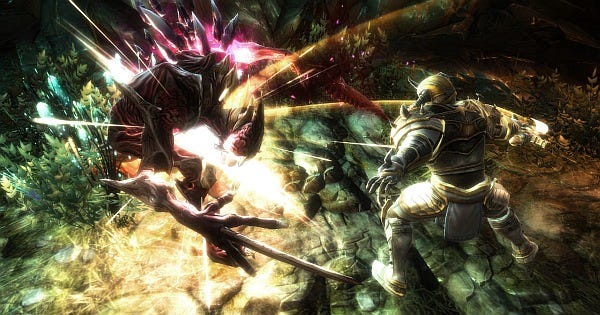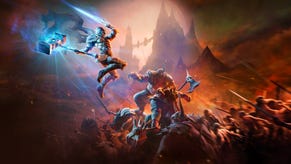Hands On Kingdoms Of Amalur: Reckoning
A force of destruction
I’m writing this about Kingdoms of Amalur: Reckoning while sat on the train on the way to go play a few hours of Skyrim, which means I’m suffering more than the usual degree of mental discombobulation. Which open world is which? Which was the one with the Red Legion? Which was the one where I was battling rock trolls atop wobbly rope bridges? Which was the one where I was compared to a god? (Oh yeah, that one’s both of ‘em.) That’s the thing with vast, free-form RPGs: there’s only so much room in your head. Usually we only have one at a time to contend with, but 38 Studios’ surprisingly sandbox roleplayer is due to arrive at about the time we’ll have finished climbing Skyrim’s icy mountains and be ready for something else. If all goes to plan, we’re going to be spoilt for choice.
Not that these are entirely comparable games beyond the superficial. Kingdoms of Amaretto is far more about combat than world simulation, with the hyperstabby likes of God of War namechecked as inspirations. You can wander the land at will and have a few pick-a-response conversations enroute, but for the most part you’ll be dancing the artfully-posed dance of death against a legion of assorted monsters, thugs and especially the Fae, a sinister race out to do all manner of nastiness to humanity and its elven and gnomish allies. (I’ll guess that dwarves crop up at some point too, but don’t quote me on that. Point is, Reckoning doesn’t fall too far from the trad. high fantasy tree, albeit opting for a grimdark take on it).
In a way, it’s comparable to an MMO – you vs a world divided into quest-packed, monster-guarded zones of varying difficulty. Rest assured it’s built from tailored challenges not generic killing fields, though – some side quests do have the kill x of x structure, but x at least tends to be ‘massive bloody rock troll that’s probably going to kill you.’ You’ll also find more esoteric stuff – wandering around the woods, I was asked to help act out a improvised ballad intended to summon a big bad. I had the option of sticking to the ballad’s intended, ultra-earnest writing or picking pithy, snarky lines that the other performer was forced to adapt to. Minor stuff for sure, but it’s life on the battlefield and I got the sense there’d be rather a lot of it.
I also stumbled across a freelance fighter’s guild, The Warsworn, who’d welcome me into their fight against thieving rotters The Red Legion if I could perform a few tasks for them – taking out some boss fight-inducing Legion leaders for a start. This was about 40 minutes into the game, by which point I’d entirely forgotten about and abandoned the main quest. Happily, the game didn’t seem to want to fuss about getting me back on its straight and narrow – my own devices seemed to take easy priority.
I was glad of this, as the storyline in the three hours I played didn’t manage to grip me and seemed bogged down in an explosion of lore. Something about destiny, something about me dying but being resurrected by gnomes (their first success in that field, apparently), something about a special power I had, the titular Reckoning, which enabled me to rewrite and erase the fates of enemies when I activated, something about my abilities being godlike… It’s all fine, I’m sure, but I just wanted to go off-piste, get away from the exposition and explore the game’s world and skill tree. This latter is intended to adapt to you, rather than you to it. Rather than being locked to a class, you pick the Destiny. This, essentially, is a secondary skill tree, a collection of buffs which you can select based on the upgrades you’ve picked so far. So, if you have poured all your points into wizardly abilities, you’ll be able to select a Destiny that offers improvements to your magickability. If, however, you’ve picked two-thirds mage skills and one-third rogue skills, you’ll find a different option is open to you – offering broader boons in both fields. So, the point is you’re not penalised for walking a hybrid path and not trying to construct the most mathematically-sensible character build.
Some might argue it’s homogenising the roleplaying experience, putting everyone on a more or less equal footing, but Reckoning seems determined to have you indulge yourself in whatever playstyle you prefer. It’s also all about the megabiff however you play – opting for a mage character, I found that I was dishing out enormous damage at long and medium range, especially once I picked up a Sceptre. Or ‘stick of lightning death’, as my notes have it. This is a singeplayer game: whatever class you build, you’re hardly going to end up in a support role. There’s more than a little Fable in there, in terms of you’re a force of destruction no matter how you design your character, but this is resolutely freed from the narrow pathways and repeating areas that Lionhead’s series seems so unwilling to leave behind.
I went in to Kingdoms of Alan expecting an ornate but stupid hack’n’slash game, and came out impressed by a fully-fleshed roleplayer that quickly set me free. In the build I played, there was a certain slickness absent – the inventory rapidly became a mess of indistinct items, the dialogue seemed so-so, the aesthetic seemed muddy – but I’m okay with that. If Reckoning can keep up its non-prescriptive ‘here are your tools, here is the world’ approach across 20-odd hours of adventuring, we’ve got quite the post-Christmas treat waiting for us.
Start-to-hat time: 30 minutes.
Kingdoms of Amalur: Reckoning, developed by 38 Studios and published by EA, is due for release early next year.



















